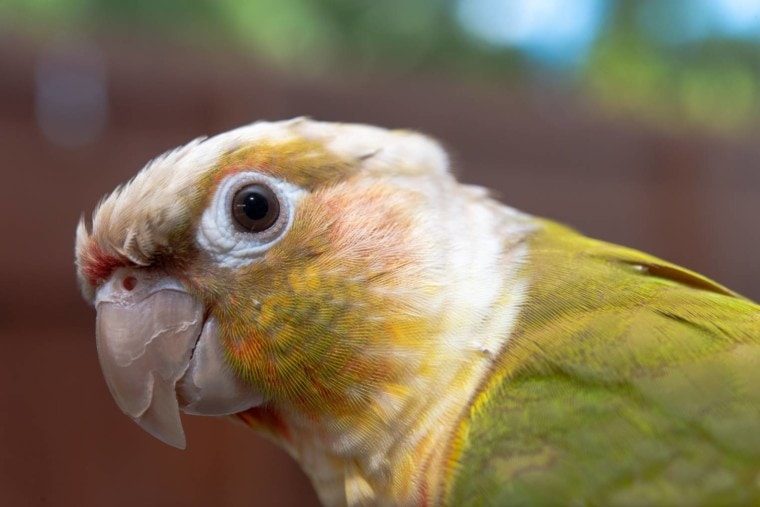
Click to Skip Ahead
The Pineapple Green-Cheek conure is a color mutation of the Green-Cheek conure. Whereas the Green-Cheek conure has red and blue on a green plumage, the Pineapple variant has yellow in place of the blue splashes of color.
Pineapple Green-Cheek Conure Overview
| Color: | Yellow, Red, Orange |
| Size: |
10 Inches |
| Weight: | 3 Ounces |
| Wingspan: | 5 Inches |
This color variation does occur in the wild, and breeders attempt to replicate this natural coloring through breeding programs and deliberate breeding. This color mutation is still somewhat rare, however, which means you will need to find a specialist store or breeder to be able to find an example of the bird.
Other than the color difference, the Pineapple Green-Cheek conure is similar to the standard in every other aspect so it is a friendly bird, although it will need training not to bite from a young age. It can be noisy and does require plenty of time out of its cage, but it is lively, energetic, and a fun pet bird.
The Pineapple Green-Cheek conure is a lively and energetic bird that enjoys being with other conures and with its human family. Its unusual coloration does occur naturally in the wild but is rare, and breeders have attempted to replicate the yellow feathering of the bird with some success. Despite this intentional breeding, the variant is still somewhat difficult to come by.
Pineapple Green-Cheek Conure Characteristics
.
History & Natural Habitat

Green-Cheek Conures are found wild in South America and specifically in woodland areas in countries including Argentina, Bolivia, Brazil, and Paraguay. They are social birds that live in flocks of up to 20 birds, but several flocks can group together if there is a natural abundance of food.
Although research on wild conures is scant, a study in the 1980s discovered a variant of the Green-Cheek conure that had yellow plumage. On this discovery, breeders and keepers attempted to replicate and encourage the unusual coloring and came up with Yellow-Sided Green Cheek conures, a forerunner to today’s Pineapple Green-Cheek conures.
Conures are relatively new to the global pet parrot trade. Even 20 years ago, they were rarely seen for sale, and even when they were, they were only really bought by enthusiasts. Today, while they are not as popular as species like parakeets, their size and relatively low care requirements means they have become very popular indeed. The species is described as being a good beginner bird because it is easier to care for than the larger parrots.
The species is not officially listed as being under threat or endangered, but its numbers have dropped considerably in the wild. The reason for this loss is, primarily, a loss of the bird’s natural habitat.
Colors and Markings
The standard Green-Cheek conure’s body is primarily made up of green feathers but with some red and blue feathers interspersed. They have green cheeks, which gives them their common name, and they tend to have a red patch on the chest. The first wild equivalent to the Pineapple Green-Cheek conure had yellow feathers in place of blue, which meant that it was still primarily green around the body.
However, breeding attempts and progression have seen the Pineapple most commonly having a full yellow body, although variations in colorings and markings do exist. The rest of the markings are the same as in the standard variant of the species, including the green cheeks.

Where to Adopt or Buy
Although conures are prevalent in the pet parrot industry, and Green-Cheek conures are among the most popular of the species, Pineapple Green-Cheek conures are a lot less common and are considered one of the most difficult color mutations to get hold of. As such, finding one might be the most difficult aspect of owning one.
They are rarely found in pet stores, and not even specialist stores will usually stock this variant. Therefore, you will need to find a breeder. When buying from a breeder, determine whether the birds are parent-raised at all, whether they have had veterinary checks, and whether they have been vaccinated. You should be able to meet the mother before agreeing to buy one of the babies, and you can use this opportunity to see markings and even get some idea of what the young bird’s character will be like.
Conures can live up to 30 years, which is longer than some owners realize when they take the bird on. As such, you may be able to find some Pineapple Green-Cheek conures in rescues or shelters, although this is rare. Check classified and local ads and don’t forget to ask anybody you know who owns this type of bird. They may be able to put you in touch with a breeder.
Conclusion
Pineapple Green-Cheek conures are rare color variants of the popular Green-Cheek Conure breed. They have yellow bodies, which give them the pineapple in their name, and they share the same positive attributes that make the conure such a popular pet bird. You can expect a bird that is friendly, will bond with you, and one that is relatively low maintenance.
However, its rarity means the Pineapple Green-Cheek conure is not easily found in pet stores and you will likely need to find a specialist breeder to get one of these birds.
Related Reads:
- Black-Capped Conure: Personality, Food & Care Guide (With Pictures)
- Best Conure Foods – Reviews & Top Picks
Featured Image Credit: Treetstreet, Shutterstock








